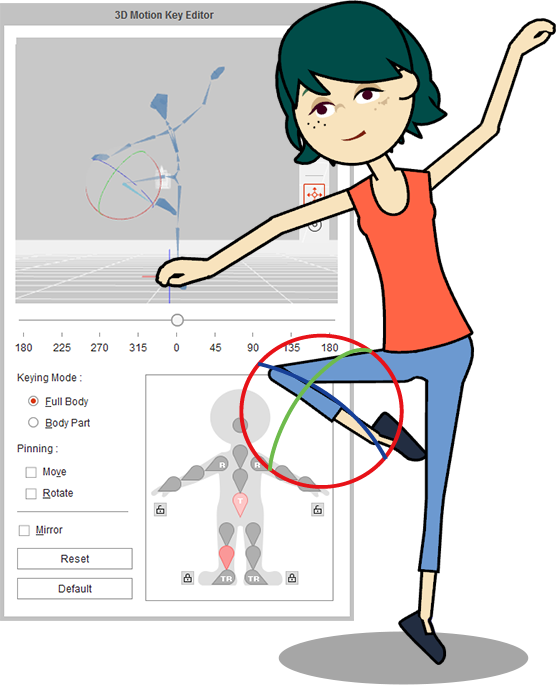

The exceptions were Misterjaw and Crazylegs Crane, which were produced specifically for television and never re-released theatrically, resulting in laughter-only versions. Repackaging over the years has resulted in both theatrical and television versions of the entries being available. The soundtracks were restored to their original theatrical form in 1982 when the DFE theatrical package went into syndication. Tom and Jerry, Woody Woodpecker, Looney Tunes, Popeye) did not receive this addition.
LEARN ANIMATION IN CARTOON ANIMATOR 4 SERIES
This was an anomaly, as other theatrical cartoon series that were aired successfully on television (i.e. In keeping with this standard, NBC added a laugh track to all seasons of The Pink Panther Show, marking the first time in history that theatrical films were fitted with a laugh track for television broadcast (Season 2 utilized an inferior laugh track, utilizing isolated laugh clips from Season 1). Doug Goodwin composed the show's opening title music while William Lava and Walter Greene composed music scores heard throughout the cartoons, many of which were variations on Mancini's "Pink Panther Theme".īy the time of the show's 1969 debut, fitting cartoon and children's shows with a laugh track was standard practice. Henry Mancini composed " The Pink Panther Theme" for the live action films, which would be used extensively in the cartoon series as well. The 32 All New Pink Panther Show entries were eventually released to theaters by United Artists. The tenth season featured 16 episodes with 32 new Pink Panther cartoons, and 16 featuring Crazylegs Crane: no bumpers were produced for The All New Pink Panther Show, but 10 second "Stay tuned." bumpers explaining an upcoming entry were produced for the first several episodes. Īfter nine years on NBC, the Pink Panther moved to ABC in 1978 and was retitled The All New Pink Panther Show and Pink Panther Encore, where it lasted two seasons before leaving the network realm entirely. This version performed poorly and eventually reverted to the original 30-minute version in 1977 as Think Pink Panther. In 1976, the half-hour series was revamped into a 90-minute format, as It's the All New Pink Panther Laugh-and-a-Half Hour-and-a-Half Show Introducing Misterjaw this version included a live-action segment, where comedian Lenny Schultz would read letters and jokes from viewers. īy this time, due to the violent nature of some of the cartoons, they were re-edited for television by omitting the cartoon violent scenes from their broadcasts, in order to make them more family friendly. The New Pink Panther Show and later shows featured newly animated bumper segments involving the Panther, the Ant and the Aardvark, Misterjaw, and the Texas Toads. Texas Toads), Hoot Kloot, Misterjaw, Roland and Rattfink, The Dogfather and two Tijuana Toads spinoffs: The Blue Racer and Crazylegs Crane. A number of new series were created, including the very popular The Ant and the Aardvark, Tijuana Toads (a.k.a. Pink Panther shorts that were produced after 1969 (starting with A Fly in the Pink) were made for both broadcast and theatrical release, typically appearing on television first, and released to theaters by United Artists. Bumper sequences consisted of newly animated segments as well as recycled footage from existing cartoons We Give Pink Stamps, Reel Pink, Pink Outs and Super Pink, fitted with new incidental music and voice-over work from Miller. The 30-minute show was then connected via bumper sequences featuring both the panther and Inspector together, with announcer Marvin Miller acting as an off-camera narrator talking to the panther. Due to the number of shorts produced, two episodes feature a Pink Panther cartoon sandwiched by two Inspector entries. When The Pink Panther Show first aired in 1969, it consisted of one cartoon featuring The Inspector, sandwiched by two Pink Panther entries. The series was produced by Mirisch Films and DePatie–Freleng Enterprises, and was broadcast Saturday mornings on two American television networks: from September 6, 1969, to September 2, 1978, on NBC and from September 9, 1978, to August 30, 1980, on ABC. DePatie and Friz Freleng between 19, starring the animated Pink Panther character from the opening credits of the live-action films.

The Pink Panther Show is a showcase of animated shorts produced by David H. Title card from the 1980 syndicated version of The Pink Panther Show


 0 kommentar(er)
0 kommentar(er)
